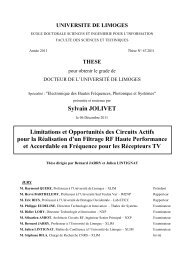Contribution à la conception optimale en terme de linéarité et ...
Contribution à la conception optimale en terme de linéarité et ...
Contribution à la conception optimale en terme de linéarité et ...
You also want an ePaper? Increase the reach of your titles
YUMPU automatically turns print PDFs into web optimized ePapers that Google loves.
III.3. - METHODOLOGIE ACTUELLE DE CONCEPTION D’AMPLIFICATEUR<br />
MULTIPORTEUSE ..................................................................................................... 94<br />
III.3.1. - Cas <strong>de</strong> figure 1 :....................................................................................... 94<br />
III.3.1.1. - Détermination <strong>de</strong> l’impédance <strong>de</strong> charge <strong>optimale</strong>......................... 94<br />
III.3.1.2. - Détermination <strong>de</strong> l’impédance <strong>de</strong> source <strong>optimale</strong>......................... 97<br />
III.3.2. - Cas <strong>de</strong> figure 2 :....................................................................................... 99<br />
III.3.2.1. - Détermination <strong>de</strong> l’impédance <strong>de</strong> charge <strong>optimale</strong>......................... 99<br />
III.3.2.2. - Détermination <strong>de</strong> l’impédance <strong>de</strong> source <strong>optimale</strong>....................... 101<br />
III.4. - NOUVELLE APPROCHE DE CONCEPTION D’AMPLIFICATEUR<br />
MULTIPORTEUSE ................................................................................................... 102<br />
III.4.1. - Definition du critère optimum d’évaluation <strong>de</strong> compromis<br />
<strong>linéarité</strong>/consommation ................................................................................................... 102<br />
III.4.1.1. - Caractéristique <strong>de</strong> bruit d’un amplificateur................................... 102<br />
III.4.1.2. - Lieu <strong>de</strong>s optima............................................................................. 103<br />
III.4.1.3. - Algorithme <strong>de</strong> construction du lieu <strong>de</strong>s optima ............................ 107<br />
III.4.2. - Utilisation du critère.............................................................................. 111<br />
III.4.2.1. - Choix d’une cellule élém<strong>en</strong>taire.................................................... 111<br />
III.4.2.2. - Choix d’un point <strong>de</strong> fonctionnem<strong>en</strong>t............................................. 112<br />
III.4.3. - Conditions <strong>optimale</strong>s <strong>de</strong> fonctionnem<strong>en</strong>t d’un transistor...................... 114<br />
III.4.3.1. - Impédances <strong>optimale</strong>s ................................................................... 115<br />
III.4.3.1.1. - Impédances <strong>de</strong> charge ............................................................ 115<br />
III.4.3.1.2. - Impédances <strong>de</strong> source ............................................................ 117<br />
III.4.4. - Points <strong>de</strong> po<strong>la</strong>risation ............................................................................ 120<br />
III.5. - METHODOLOGIE DE CONCEPTION D’AMPLIFICATEUR ........................... 121<br />
III.6. - CONCLUSION ....................................................................................................... 124<br />
CHAPITRE IV 131<br />
IV.1. - INTRODUCTION................................................................................................... 132<br />
IV.2. - CONCEPTION DE L’AMPLIFICATEUR BANDE S........................................... 133<br />
IV.2.1. - Modélisation du transistor HFET.......................................................... 133<br />
IV.2.2. - Validation du modèle ............................................................................ 134<br />
IV.2.3. - Conception <strong>de</strong> l’amplificateur............................................................... 136<br />
IV.2.3.1. - Analyse <strong>de</strong> <strong>la</strong> stabilité linéaire du transistor ................................. 136<br />
IV.2.3.2. - Optimisation du transistor............................................................. 139<br />
IV.2.3.3. - Synthèse <strong>de</strong>s circuits d’adaptation................................................ 143
















